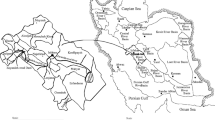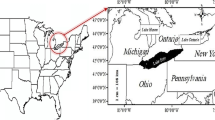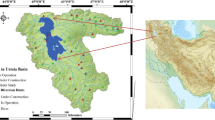Abstract
Prediction of water level fluctuations in lakes is a necessary task in hydrological and limnological studies. Lake Urmia, a hyper-saline lake in the North Western part of Iran, is dealing with a gradual atrophy. In this study, parametric and nonparametric models are used for predicting monthly water level fluctuations in Lake Urmia. Eleven previous water levels in the form of monthly lagged data are used as the known independent variables of the model while lake water level at the twelfth month is considered as the unknown dependent variable to be predicted. Parametric models used in the modelling are multi-linear regression (MLR), additive and multiplicative non-linear regression (ANLR and MNLR) and decision tree (DT) while feed forward back propagation neural network (FFBP-NN), generalized regression neural network (GR-NN) and radial basis function neural network (RBF-NN) are used to represent the non-parametric approach. Monthly water level data in Lake Urmia observed for 1966–2010 are used for the case study. Four criteria, coefficient of determination, Lin’s concordance correlation coefficient, performance index and root mean square percentage error are used in comparison of the models. The first two are considered for the success of the models while the last two for the failure. Success criteria are given a grade between 0 and 10, failure criteria receive a grade from −10 to 0. The summation of the grades is taken as the total grade of each model. It is found that regression models and FFBP-NN are superior to GR-NN, RBF-NN and DT in predicting monthly lake water level.









Similar content being viewed by others
References
Aksoy H, Dahamsheh A (2009) Artificial neural network models for forecasting monthly precipitation in Jordan. Stoch Env Res Risk A 23(7):917–931
Baker C, Lawrence R, Montagne C, Patten D (2006) Mapping wetlands and riparian areas using Landsat ETM+ imagery and decision-tree-based models. Wetlands 26(2):465–474
Birkett CM (1995) The contribution of TOPEX/Poseidon to the global monitoring of climatically sensitive lakes. J Geophys Res 100(C12):25179–25204
Burrows WR, Benjamin M, Beauchamp S, Lord ER, McCollor D, Thomson B (1995) CART decision-tree statistical analysis and prediction of summer season maximum surface ozone for the Vancouver, Montreal, and Atlantic regions of Canada. J Appl Meteorol 34(8):1848–1862
Crasto N, Hopkinson C, Forbes DL, Lesack L, Marsh P, Spooner I, Van Der Sanden JJ (2015) A LiDAR-based decision-tree classification of open water surfaces in an Arctic delta. Remote Sens Environ 164:90–102
Crétaux JF, Jelinski W, Calmant S, Kouraev A, Vuglinski V, Bergé-Nguyen M, Maisongrande P (2011) SOLS: a lake database to monitor in the near real time water level and storage variations from remote sensing data. Adv Space Res 47(9):1497–1507
Dahamsheh A, Aksoy H (2009) Artificial neural network models for forecasting intermittent monthly precipitation in arid regions. Meteorol Appl 16(3):325–337
Dahamsheh A, Aksoy H (2014) Markov chain-incorporated artificial neural network models for forecasting monthly precipitation in arid regions. Arab J Sci Eng 39(4):2513–2524
Dawson CW, Wilby RL (1998) An artificial neural network approach to rainfall-runoff modelling. Hydrol Sci J 43(1):47–66
Eimanifar A, Mohebbi F (2007) Urmia Lake (northwest Iran): a brief review. Saline Syst 3(5):1–8
Encyclopedia Iranica (2015) Urmia, Lake. http://www.iranicaonline.org/articles/urmia-lake. Accessed 01 Jan 2015
Hadi RM, Shokri S, Ayubi P (2013) Urmia Lake level forecasting using brain emotional learning (BEL). Proceedings 3rd International e-Conference of “In Computer and Knowledge Engineering (ICCKE)”, October 31 – November 1, Mashhad, Iran. p 246–251
Hassanzadeh E, Zarghami M, Hassanzadeh Y (2012) Determining the main factors in declining the Urmia Lake level by using system dynamics modeling. Water Resour Manag 26(1):129–145
Hornik K, Stinchcombe MB, White H (1989) Multilayer feed forward networks are universal approximator. Neural Netw 2(5):359–366
Kakahaji H, Banadaki HD, Kakahaji A, Kakahaji A (2013) Prediction of Urmia Lake water-level fluctuations by using analytical, linear statistic and intelligent methods. Water Resour Manag 27(13):4469–4492
Karbassi A, Bidhendi GN, Pejman A, Bidhendi ME (2010) Environmental impacts of desalination on the ecology of Lake Urmia. J Great Lakes Res 36(3):419–424
Khatami S (2013) Nonlinear chaotic and trend analyses of water level at Urmia Lake, Iran. M.Sc. Thesis report: TVVR 13/5012, ISSN: 1101–9824, Lund University, Lund
Kisi O, Shiri J, Karimi S, Shamshirband S, Motamedi S, Petković D, Hashim R (2015) A survey of water level fluctuation predicting in Urmia lake using support vector machine with firefly algorithm. Appl Math Comput 270:731–743
Kumar M, Raghuwanshi NS, Singh R, Wallender WW, Pruitt WO (2002) Estimating evapotranspiration using artificial neural network. J Irrig Drain Eng 128(4):224–233
Salas JD, Deulleur JW, Yevjevich V, Lane WL (1980) Applied modelling of hydrologic time series. Water Resources Publ. Littleton, Colorado
Schweizer G (1975) Untersuchungen zur Physiogeographie von Ostanatolien und Nordwestiran: geomorphologische, klima-und hydrogeographische Studien in Vansee-und Rezaiyehsee-Gebiet, vol. 9. Selbstverlag des Geographischen Instituts der Universität Tübingen
Shannon CE (2001) A mathematical theory of communication. ACM SIGMOBILE Mob Comput Commun Rev 5(1):3–55
Talebizadeh M, Moridnejad A (2011) Uncertainty analysis for the forecast of lake level fluctuations using ensembles of ANN and ANFIS models. Expert Syst Appl 38(4):4126–4135
Tooke TR, Coops NC, Goodwin NR, Voogt JA (2009) Extracting urban vegetation characteristics using spectral mixture analysis and decision tree classifications. Remote Sens Environ 113(2):398–407
United Nations Environment Programme- Global Environmental Alert Service (UNEP- GEAS) (2012) The drying of Iran’s Lake Urmia and its environmental consequences. Environ Dev 2(1):128–137. doi:10.1016/j.envdev.2012.03.011
Vaheddoost B, Aksoy H (2016) Structural characteristics of annual precipitation in Lake Urmia, Iran. Theor Appl Climatol. doi:10.1007/s00704-016-1748-3
Vaheddoost B, Aksoy H, Abghari H, Naghadeh S (2015) Decision tree for measuring the interaction of hyper-saline lake and coastal aquifer in Lake Urmia. Proceeding of Environmental and Water Resource Institute (EWRI): Watershed Management Symposium, August 5–7. ASCE Bechtel Conference Center, Reston, pp 62–71. doi:10.1061/9780784479322.006
Vaheddoost B, Zare Naghadeh S, Abghari H, Aksoy H, Ozkul S (2014) Time series analysis of water level in Lake Urmia using ANN and MLR modeling techniques. 32nd National and the 1st International Geosciences Congress, 16–19 February 2014. Urmia University, Urmia. doi:10.13140/RG.2.1.3215.1203
Zarghami M (2011) Effective watershed management; case study of Urmia Lake, Iran. Lake Reservoir Manag 27(1):87–94
Acknowledgments
The authors appreciate support by the Scientific Research Projects Unit of Istanbul Technical University through the project 39016 – Modelling Studies with Statistical Approaches for Lake Urmia. The authors would also like to thank the reviewers for their constructive comments.
Author information
Authors and Affiliations
Corresponding author
Rights and permissions
About this article
Cite this article
Vaheddoost, B., Aksoy, H. & Abghari, H. Prediction of Water Level using Monthly Lagged Data in Lake Urmia, Iran. Water Resour Manage 30, 4951–4967 (2016). https://doi.org/10.1007/s11269-016-1463-y
Received:
Accepted:
Published:
Issue Date:
DOI: https://doi.org/10.1007/s11269-016-1463-y




